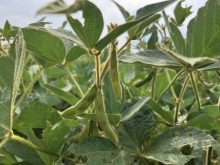New fungicide seed treatment Saltro protects soybeans from sudden death syndrome and canola from airborne blackleg, new research indicates.
The seed treatment, with the active ingredient Adepidyn, is a Group 7 fungicide belonging with the carboxamides. It works by moving through the plant’s water-conducting system and is taken into the cotyledons.
Why it matters: New seed treatments allow farmers to continue to push plant performance under varying conditions.
Syngenta has two years of data that shows Saltro provides consistent and effective protection in environments with low and high sudden death syndrome pressures in soybeans.
Read Also

The forced Japanese-Canadian farmers of the Second World War
Manitoba’s sugar beet farms drew on displaced Japanese-Canadians from B.C. during the Second World War
Soybeans treated with Saltro showed an increase in above and below ground biomass.
“This year for sudden death syndrome (we had) more early onset, more severe and a bit wider spread so it’s definitely becoming more and more of an issue,” says Scott Snyder, seed care specialist with Syngenta.
Syngenta officially announced the new seed treatment on Aug. 17.
Saltro is the first seed treatment to defend against airborne blackleg in canola at the cotyledon stage.
“With the blackleg in canola, from what I understand that issue has been around for quite a while and it’s never really had any resources or any solutions up until now. That’s what we’re mainly excited about,” says Snyder.
Research studies from the University of Manitoba and at Syngenta showed that plants treated with Saltro had significantly lower stem infection than untreated canola and canola seed equipped with blackleg seed treatment.
“As an industry, we are learning that earlier, airborne blackleg infections create a bigger risk of stem infection, which can cause lodging and cut off plants completely,” says Karen Ullman, Seed care Product Lead with Syngenta Canada. “Saltro is a new tool that will help growers prevent blackleg infections and preserve their canola crop’s yield potential.”
For the 2021 growing season Saltro will be available as a canola seed treatment package called Helix Saltro, with the inclusion of Helix Vibrance.















